Monstera is treated as amazing or bizarre. The homeland of this vine is the subtropics rich in moisture and heat. It grows in the wild to gigantic proportions, braiding not only the trunks of huge trees, but also their crowns. At home, the liana practically does not bloom, but in the wild it produces flowers and even gives fruit. Only a few species, with proper care, can bloom. The article will talk about transplantation, reproduction and diseases of this plant.
Content
- 1 Monstera - why you can not keep at home
- 2 Monstera: description with photo
- 3 Types of Monstera
- 4 Conditions for keeping, caring and breeding monstera
- 5 Lighting
- 6 Content temperature
- 7 Watering and moisturizing
- 8 Top dressing
- 9 Liana formation
- 10 Circumcision
- 11 Reproduction and transplantation of monstera
- 12 Monstera Flower - Signs and Superstitions
Monstera - why you can not keep at home
In addition to the fact that the monstera is a poisonous plant, there are still a huge number of different legends and beliefs why you can not keep it at home. Even experienced flower growers recommend growing it only in offices and other non-residential premises.
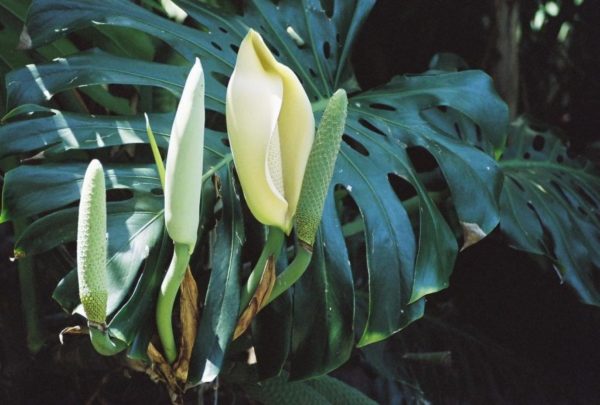
If you look at all these conjectures, no matter how real they are, science does not prove the harm of monstera to humans. The juice of the plant is not even an allergic, not that poison. What was found in the tissues of the monstera is a substance that causes irritation of the mucous membranes. This is the biggest drawback of the monstera. Therefore, you can keep it in the house, it is practically not poisonous.
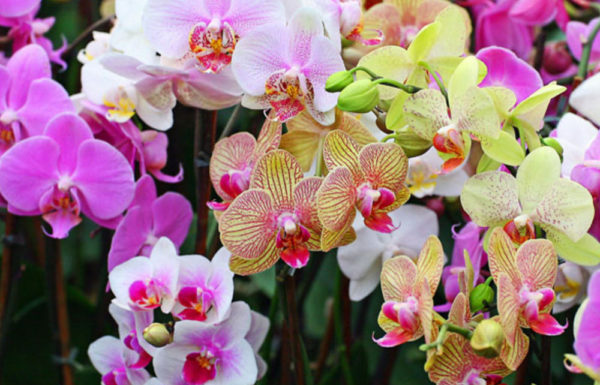 You may be interested in:
You may be interested in: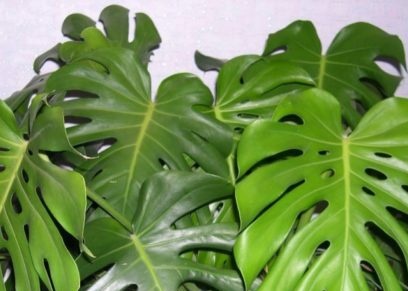
In many Asian countries, on the contrary, it symbolizes well-being, happiness and success. Some even specially plant it in front of the house, with the confidence that the plant will protect the family from the evil eye and other negativity. In some houses of Asian residents, a cache-pot with a monster is placed at the head of the seriously ill, they believe that the plant absorbs the negative and helps the person recover. Caring for a monster at home can cause some difficulties.
Therefore, if you decide to buy a plant and make friends with it, it is better if you place it in the dining room, living room or hall, but not in the bedroom or the nursery!
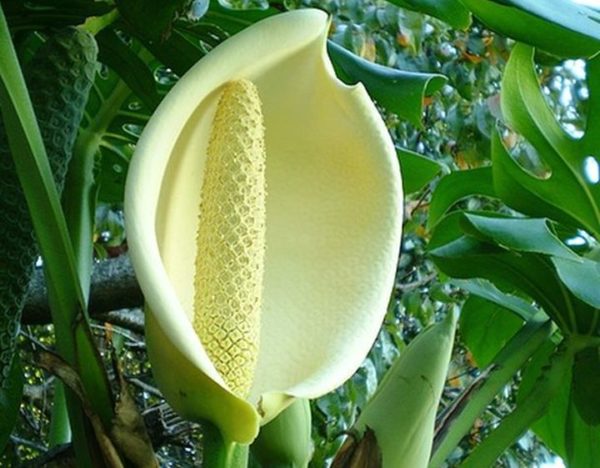
In the office, the monstera is able to provide a charge of vivacity and a raising tone, increase work efficiency. The best room would be where the negotiations take place.
Monstera: description with photo
Monstera (lat. Monstera), as mentioned above, is a large tropical plant, that is, a vine with cut huge leaves and a growth point at the top of the shoot. The plant belongs to the Aroid family.
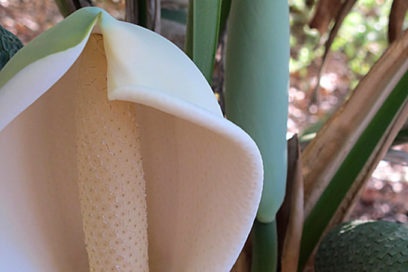
At home, the liana throws out leaves reaching a diameter of up to 50 centimeters.The color of the leaves is deep green, sometimes with light veins or spots. Liana has many aerial roots that help her exist. At home, growing a monstera, these roots should be sent to the ground, but if this is not possible, then attach special earth packets to them.
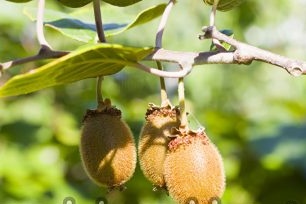 You may be interested in:
You may be interested in:Types of Monstera
Monstera gained particular popularity in the XVIII century. Thanks to the British colonies, she came to India, then began to rapidly spread to the East. Today, the plant is considered one of the most popular indoor flowers.
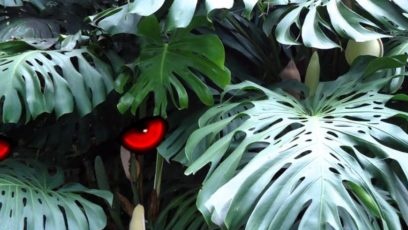
The genus Monstera has more than 45 species of plants, only at the end of the twentieth century, six new species were discovered and described. Some types of monstera require special care at home, as in the photo.
Monstera Adanson
It was discovered in the rainforests of Costa Rica and Brazil. Reaches a height of more than 15 meters. The width of the sheet is from 15 to 40 centimeters, the length is from 22 to 55 centimeters, on thin leaves there are many small holes. Flowering occurs mainly in freedom: a short peduncle 10-12 cm in length and a diameter of not more than 2 cm. It has small light yellow flowers.
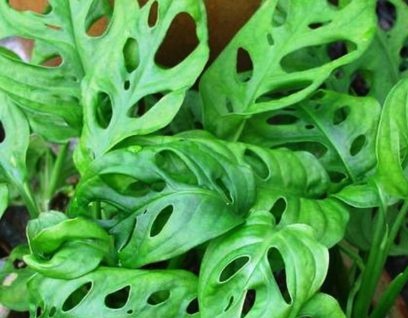
Young foliage has a heart-shaped shape, with age, the leaf begins to divide and tear. When flowering on a white bedspread, an ear is formed. It has edible fruits with the smell of pineapple.
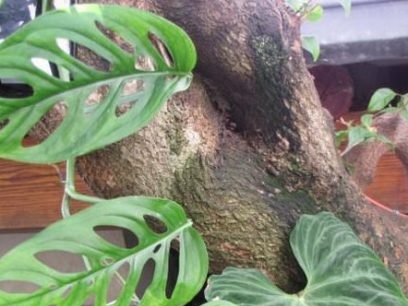
Grown plants in greenhouses reach 12-24 meters, but in houses the length of the whip does not exceed 5-6 meters. This type of monstera can bloom at home, but only under proper conditions. The fruit ripens for more than 10 months. Monstera flower cannot boast of special beauty, but it looks interesting.
Biologists are familiar with the motley coloring of this species, but, unfortunately, it is more demanding on living conditions and takes root worse in residential premises.
Monstera Borzig
The birthplace of this type of monster is considered Mexico. It is much smaller than Delicacy, the stems are much thinner, the leaves are rarely more than 30 centimeters. It is much more common in florist houses.
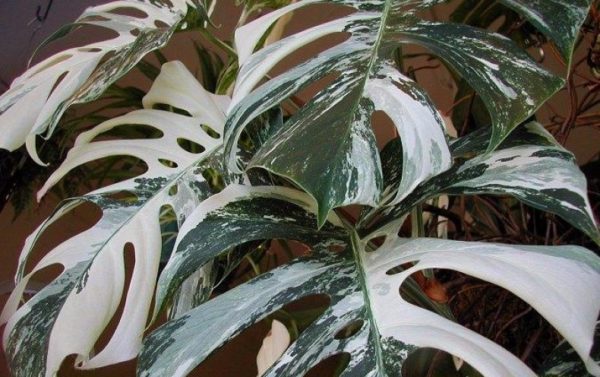
The leaves have an oblong shape up to 20 cm long and 5-6 cm wide. Their whole shape has different sides at the base. Flowers are on a short peduncle. In indoor conditions, it does not bloom.
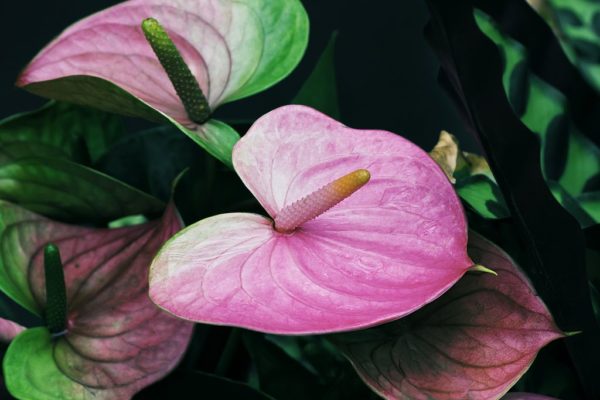 You may be interested in:
You may be interested in:Monstera oblique
Oblique monstera is often called punched or perforated, it grows in the humid forests of the American tropics. By their appearance, the leaves resemble the shape of a very large egg, sometimes reach 80 centimeters in length and 30 centimeters in width and are unevenly covered with holes.
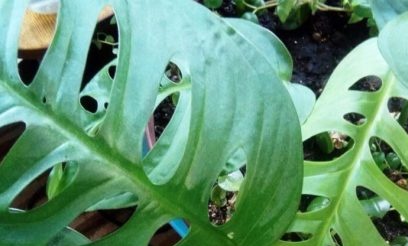
Conditions for keeping, caring and breeding monstera
Most often, Monstera Delicatessen is bred in room conditions, she is well taken root among gardeners. Its continuous glossy leaves become carved over time and have a decorative beautiful shape. With skillful care, it often blooms and gives edible fruits.
But before you eat them you need to make sure that they are fully mature, otherwise you can get a burn of the oral mucosa and a slight poisoning that requires washing the stomach. With inept care of the monster at home, the leaves may dry.
Lighting
Although many talk about the monster as a shade-tolerant plant, it is not true that it can do without lighting. Natural photosynthesis of the plant takes place with bright and diffuse consecration, but temporary blackouts are necessary. This means that the plant responds positively to the light and loves partial shade. In complete shade, the leaves will turn pale and the plant will stop growing.
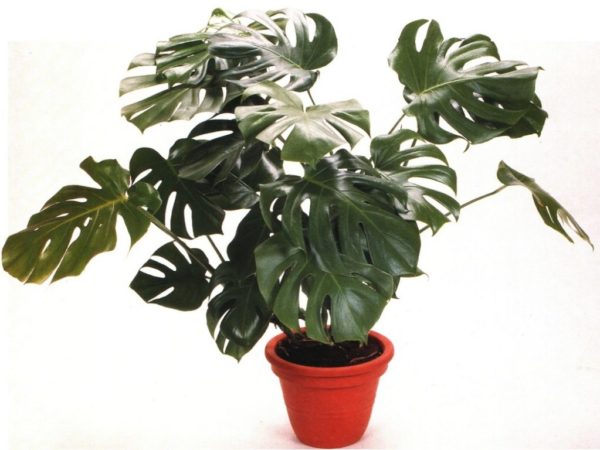
Western and eastern windows and rooms would be ideal for creepers. You should not just as often change the position of an adult plant, it is very long and difficult to survive such stress. Decorative leaves often deteriorate, they begin to turn yellow and dry.
Content temperature
A suitable temperature for almost all creeping vines is considered to be from +18 to +25 degrees, but this is only in the spring-summer period, when it grows and releases new leaves. In the late autumn and winter, a dormant period sets in, the air temperature should be lower from +16 to +19 degrees.
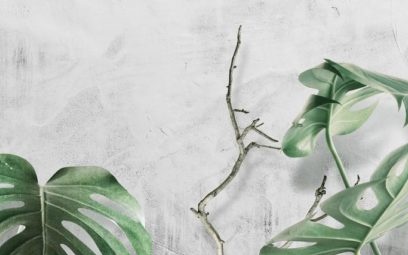
The plant does not like drafts at all and reacts to them instantly.
Watering and moisturizing
For irrigation, it is necessary to use settled water at room temperature. Liana needs to be watered 1-2 times a week, avoiding root decay. With strong and constant waterlogging, yellow spots appear on the leaves. Drying of the soil is also unacceptable, the monstera immediately begins to wither.
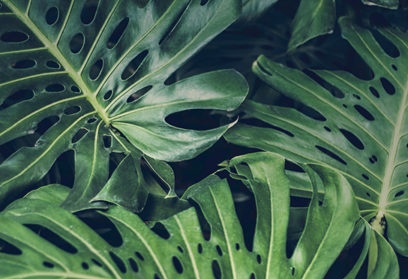
An excellent means is moisturizing with filtered water, which does not leave a white coating on the leaves. In addition to spraying, you need to wipe the leaves weekly with a soft and damp cloth, removing dust and returning the gloss to the plant.
Top dressing
For the normal development of creep, top dressing vines are especially necessary. During the period of active growth, it is necessary to fertilize it 1-2 times a month, 2-3 hours after watering.
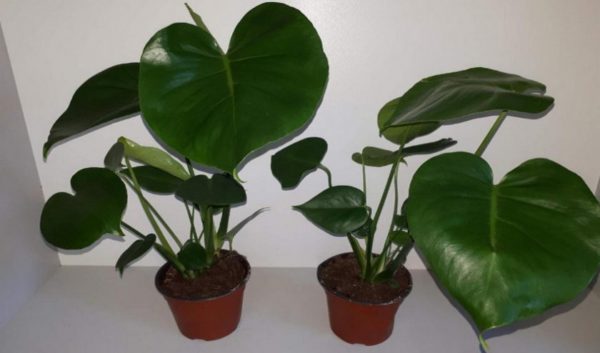
As feed, you can use special complex concentrates purchased in stores, fertilizers of the Master firm are excellent for these purposes. As for young animals, with the right soil for planting, the first year the plant does not need to be fed.
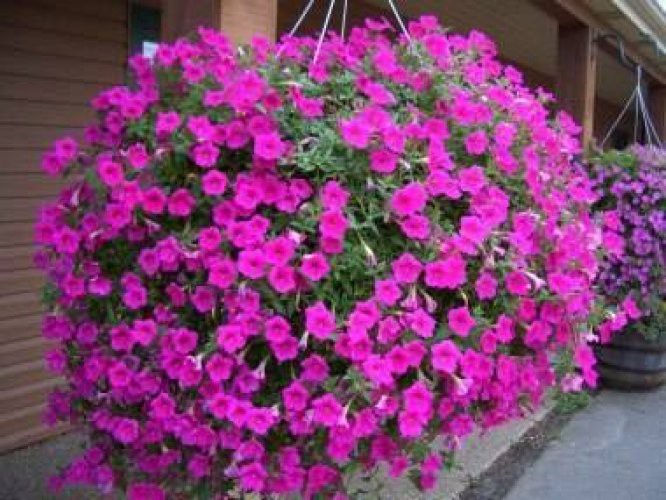 You may be interested in:
You may be interested in:Liana formation
Monstera is a creeping vine and she needs support. For this purpose, you can use a beautiful and elegant lattice, all kinds of support rails, decorative cords and other supporting decorative elements.
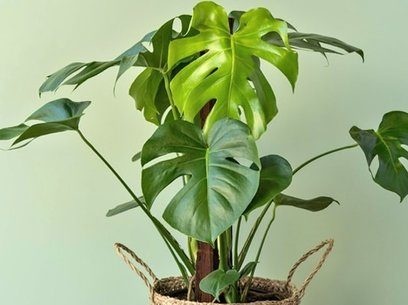
It is very convenient to use pipes wrapped in palm fiber. They are convenient in that they can drill holes for aerial roots, and fill with soil. Further, as the plants grow, direct the roots into them. In this case, more than one problem is solved:
- Reliable support.
- Full nutrition for the entire lash.
Circumcision
With age, the liana loses its decorative effect, dropping leaves from the beginning of the stem, and does not look so impressive. To rejuvenate the plants, pruning is used, which helps to activate the growth of side shoots. To do this, cut off the growth point.
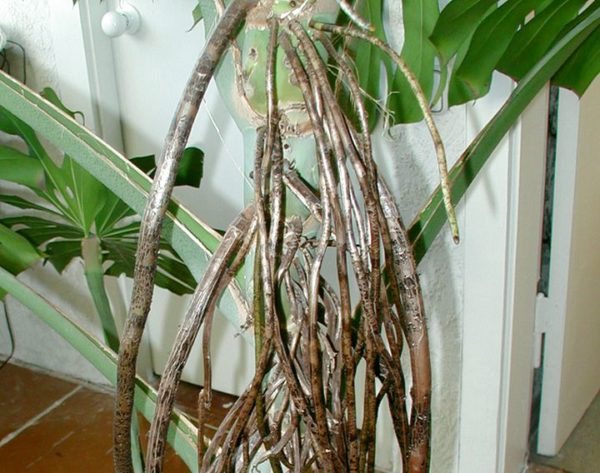
Trimming aerial roots is not allowed. Those roots that can be directed into the pots with soil are fixed in place, those that are not available must be wrapped in moist moss or lowered into small jars.
There is a strong and stable support, it is recommended for each root to put a small pot filled with earth, for rooting aerial roots. Growing a monster at home, requires some care for her, as in the photo.
Reproduction and transplantation of monstera
Until three to four years of age, the liana grows rapidly, so it needs an annual transplant.After 5 years, it is enough to change the upper part of the soil in a pot - once every 3-4 years. To plant plants, you need to take a volumetric flower pot and lay down high-quality drainage material.
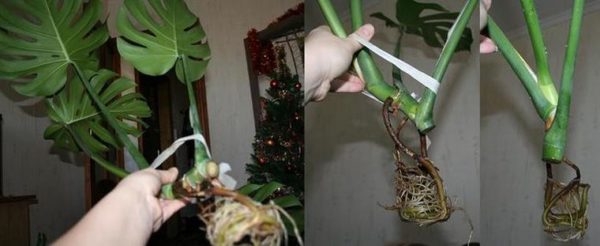
For the root system of the monstera, a large intake of air is very important. With proper care of the monster at home, the first years require a transplant.
In order to make land for planting youngsters, monsters will need:
- 1 part of turf land;
- 1 part of peat land;
- 1 part humus;
- 1 part of river sand.
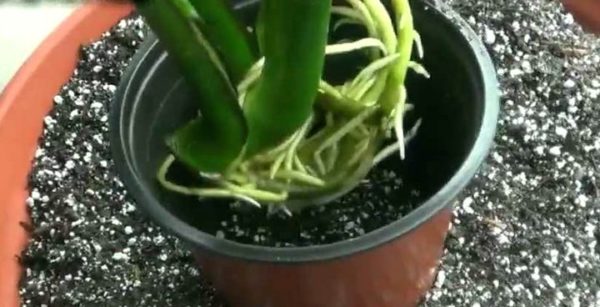
For adult plants, a pH of 6.5-7.0 is needed, the earth consists of:
- turf - 3 parts;
- peat - 1 part;
- deciduous - 1 part;
- humus - 1 part;
- river sand - 1 part.
Breeding
In indoor conditions, Monstera is most efficiently propagated by processes or cuttings. Propagation of this plant is mostly win-win. The best time is the period from March to June. To do this, use lateral processes extending from the bottom of the lash and having aerial roots.
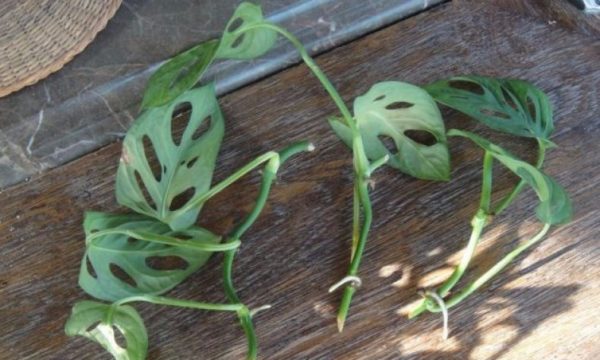
Pre-prepared and dried cuttings in places of slices are deepened with a cache-pot with soil, the air root is also sprinkled with earth. Planted cuttings are moistened, sprinkled with a layer of sand and imitate a small hotbed using a can, glass or film. As you can see, breeding at home monsters is not so difficult.
Monstera Flower - Signs and Superstitions
Many myths and superstitions revolve around monsters. Many consider it to be almost a flower of a demon who wants to harm a person.
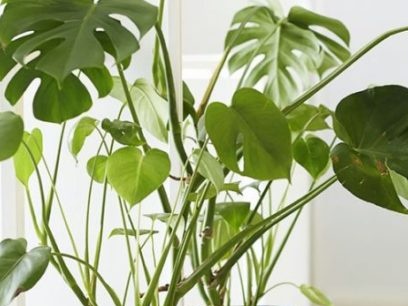
Let's try to refute some of them.
- At night, the liana absorbs oxygen with frantic force, if a person in a sleeping state is in a closed room with her, asphyxiation can occur. Not true! Monstera is just an ordinary plant, which, like many at night, absorbs oxygen, and releases it during the day. Therefore, if you follow this statement, then you can’t grow flowers in houses and apartments at all! But the fact that the liana moisturizes the air and collects the main dust on its leaves is true!
- They also talk about the special toxicity of the liana, supposedly, if it is touched, then a skin burn is ensured, poisoning is also possible up to a fatal outcome. In fact, on the back of some types of monstera there are small needles. But in order for them to get on the mucous membrane, they need to be put in the mouth, then it is possible that you will prick. The study of monstera is still being studied by science, but there was still no evidence that the plant could threaten human life. But the fact that she is a favorite delicacy of some peoples of India and Australia is true! Eat not only ripe fruits, but also some parts of the plant.
- Another creepy myth says that a monstera is able to strangle a person or feeds on human flesh. In fact, these hypotheses were brought by travelers who found human skeletons entangled in the roots of the plant, but there is no confirmation of this. After all, a flower could let its parts through long-dead people or animals.
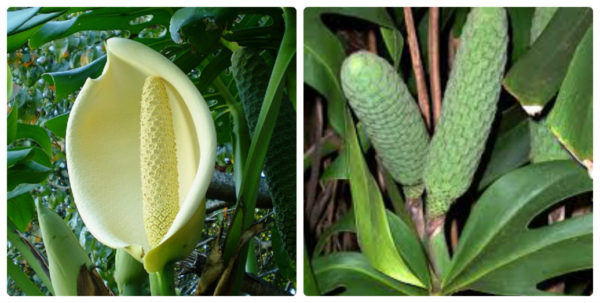
A sufficient amount of information for cultivating a green beauty has been described in the article. Of course, there will be a lot of trouble with her, but if you succeed, then she will thank you with a chic look. In defense, it should be added that the monstera supplies the room with ozone, oxygen, air ions, absorbs colorless gas and formaldehydes.
In addition to the above, it also heals and soothes the nervous system, regulates the rhythm of the heart, and relieves headaches. Make a conclusion whether it is possible to keep a monster at home.




 10 beautiful annuals that bloom all summer
10 beautiful annuals that bloom all summer Sow in the ground, without seedlings: 10 beautiful and unpretentious flowers
Sow in the ground, without seedlings: 10 beautiful and unpretentious flowers Platicodon planting and outdoor care
Platicodon planting and outdoor care Hosta - planting and care in the open ground in the Urals
Hosta - planting and care in the open ground in the Urals